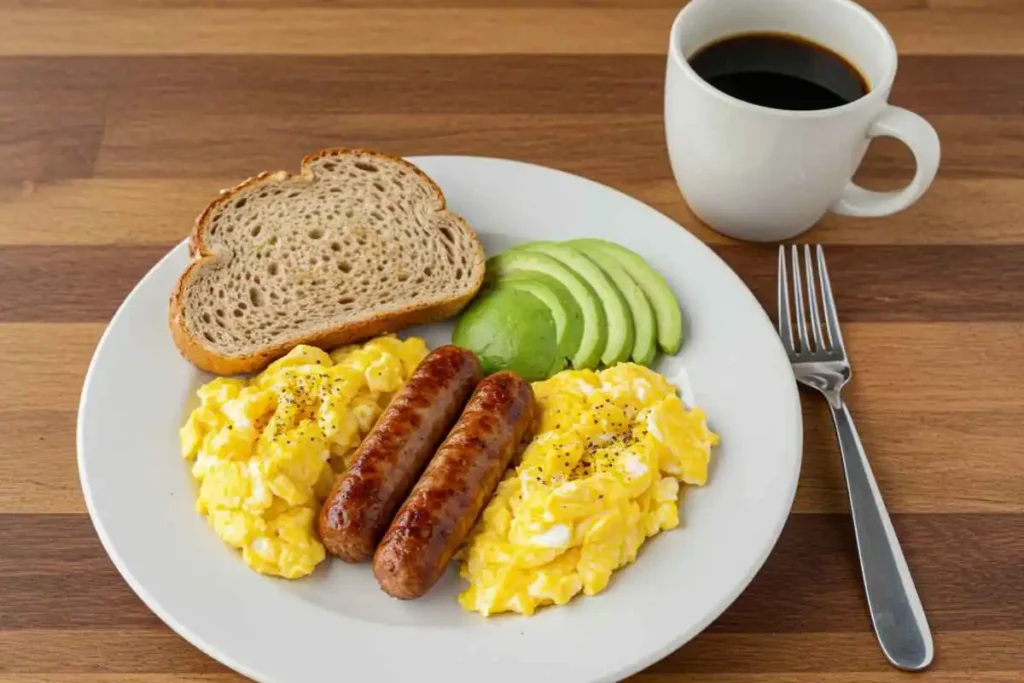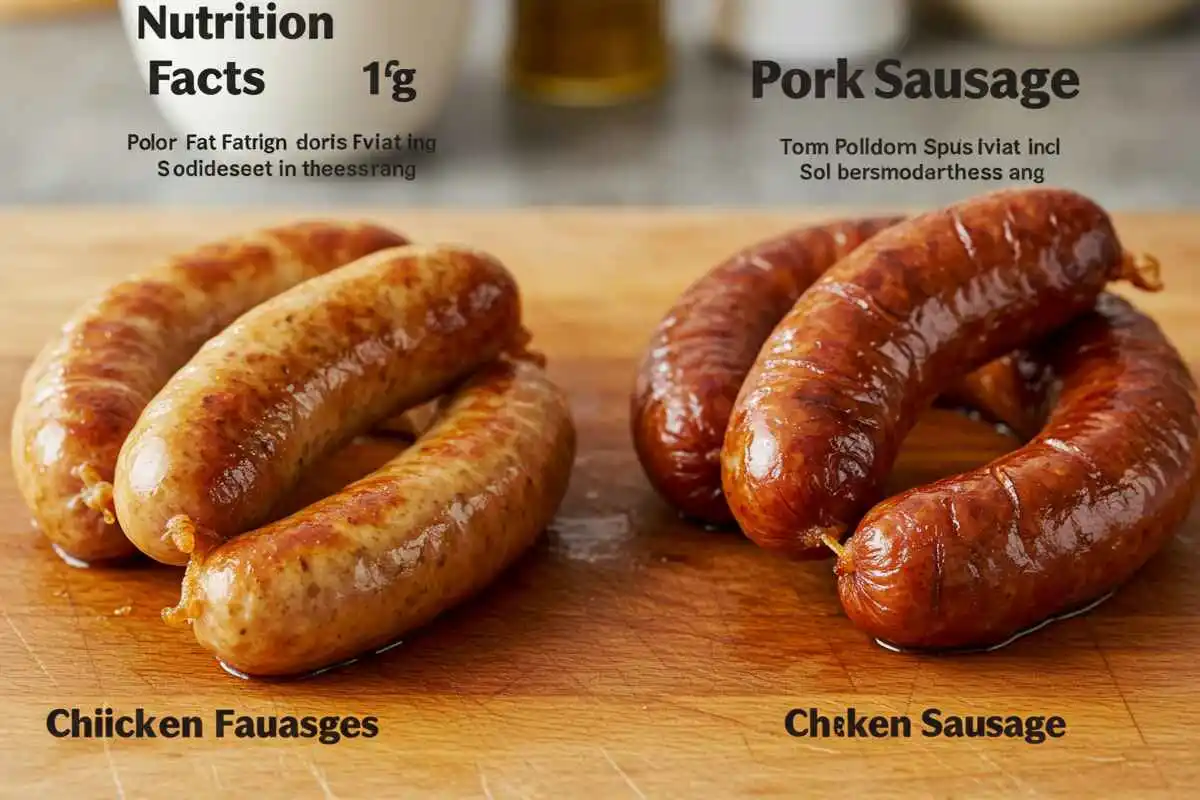1. Introduction
Breakfast is often called the most important meal of the day, and for many, sausages are a staple part of their morning routine. However, with growing health concerns surrounding processed meats, many people are looking for healthier alternatives. This is where chicken breakfast sausage comes in. But the question remains: Is chicken breakfast sausage healthy?
Chicken sausage is widely marketed as a better alternative to traditional pork sausage. It is often praised for having lower fat content, fewer calories, and a high protein profile. However, like any processed food, the healthiness of chicken sausage depends on various factors, including ingredients, sodium levels, preservatives, and portion sizes.
In this article, we’ll take an in-depth look at the nutritional profile of chicken breakfast sausage, comparing it to other types of sausages, discussing its benefits and potential downsides, and providing tips on choosing the healthiest options available. By the end of this guide, you’ll have all the information needed to decide whether chicken sausage is a good fit for your diet.
Now, let’s dive into the nutritional comparison of chicken breakfast sausage versus other common sausage varieties.
2. Nutritional Comparison
When assessing whether chicken breakfast sausage is a healthy option, it’s essential to compare its nutritional profile to other common breakfast meats. Let’s break it down by calories, fat content, and protein levels.
2.1. Chicken Sausage vs. Pork Sausage
Traditional pork sausage is higher in fat and calories compared to chicken sausage. Here’s a quick nutritional comparison per one standard link (about 85g):

| Nutrient | Chicken Sausage | Pork Sausage |
|---|---|---|
| Calories | 140-160 kcal | 220-250 kcal |
| Protein | 13-16g | 11-14g |
| Total Fat | 7-10g | 18-22g |
| Saturated Fat | 2-3g | 7-9g |
| Sodium | 400-600mg | 500-800mg |
From this table, we can see that chicken sausage contains fewer calories and less saturated fat than pork sausage, making it a healthier choice for those watching their fat intake. Additionally, chicken sausage provides more protein per calorie, which is beneficial for muscle growth and repair.
However, one concern is the sodium content, which can be relatively high in both types of sausages. High sodium intake is linked to increased blood pressure and heart disease, so it’s crucial to check labels and opt for low-sodium varieties when possible.
2.2. Caloric Content
One of the reasons many people prefer chicken sausage over pork sausage is its lower calorie count. While pork sausage can contain up to 250 calories per link, chicken sausage typically ranges between 140 to 160 calories per serving.
For individuals aiming to lose weight or maintain a calorie-controlled diet, substituting pork sausage with chicken sausage can save 80 to 100 calories per meal. Over time, this reduction can significantly contribute to a caloric deficit, promoting weight loss.
However, it’s important to consider what the sausage is paired with. If served with buttery biscuits, fried eggs, and cheese, the overall meal may still be high in calories despite choosing a leaner sausage.
2.3. Fat Content
One of the biggest advantages of chicken sausage is its lower fat content compared to pork sausage. While traditional pork sausage contains 18-22 grams of fat per serving, chicken sausage contains 7-10 grams—less than half the amount.
Furthermore, chicken sausage contains less saturated fat—only 2 to 3 grams per serving compared to the 7 to 9 grams found in pork sausage. High intake of saturated fat is associated with an increased risk of heart disease, high cholesterol, and inflammation.
For individuals following low-fat or heart-healthy diets, chicken sausage is a better option than pork sausage. However, some brands may add artificial fats, preservatives, and flavor enhancers to compensate for the lower fat content. Always check ingredient labels to ensure you’re selecting a minimally processed, high-quality option.
3. Health Benefits of Chicken Sausage
Chicken breakfast sausage is often promoted as a healthier alternative to traditional pork sausage, and for good reason. It offers several nutritional benefits, especially when compared to its fattier counterparts. Here are the key health benefits of incorporating chicken sausage into your diet.
3.1. High Protein Content
Protein is an essential macronutrient that plays a crucial role in muscle growth, tissue repair, and overall body function. Chicken sausage contains 13-16 grams of protein per serving, making it a great choice for those looking to boost their protein intake.
Why Is Protein Important?
- Helps build and maintain lean muscle mass
- Supports metabolism and fat loss
- Keeps you fuller for longer, reducing hunger cravings
- Aids in cell repair and immune function
Compared to pork sausage, which contains slightly less protein per calorie, chicken sausage is a more efficient protein source with fewer calories and less fat. This makes it an ideal choice for athletes, fitness enthusiasts, and individuals looking to manage their weight.
For breakfast, pairing chicken sausage with eggs, whole grains, and vegetables can create a well-balanced, high-protein meal that sustains energy levels throughout the day.
3.2. Lower Saturated Fat
One of the biggest concerns with traditional pork sausage is its high saturated fat content. Saturated fat, when consumed in excess, has been linked to:
- Increased LDL (bad) cholesterol levels
- Higher risk of heart disease and stroke
- Increased inflammation in the body
Chicken sausage, on the other hand, contains only 2-3 grams of saturated fat per serving, compared to 7-9 grams in pork sausage. This makes it a much healthier choice for heart-conscious individuals.
Additionally, some brands of chicken sausage use lean cuts of chicken, which further reduces overall fat content while maintaining a delicious flavor. When choosing a chicken sausage, look for:
Skinless chicken (lower in fat)
Minimal added oils or artificial fats
No hydrogenated oils or trans fats
By choosing a leaner protein source, you’re reducing unhealthy fat intake while still enjoying a flavorful, satisfying breakfast.
4. Potential Health Concerns of Chicken Sausage
While chicken breakfast sausage is often considered a healthier alternative to pork sausage, it is still a processed food, and certain factors could make it less than ideal for daily consumption. Below are the most important health concerns associated with chicken sausage.
4.1. Sodium Levels
One of the biggest concerns with chicken sausage—and processed meats in general—is its high sodium content.
Why Is Sodium a Concern?
Consuming too much sodium can lead to:
- High blood pressure (a major risk factor for heart disease and stroke)
- Water retention and bloating
- Increased risk of kidney disease
A single serving of chicken sausage can contain anywhere from 400mg to 600mg of sodium, while some highly processed varieties may exceed 800mg. The recommended daily limit for sodium is 2,300mg, meaning that just one or two sausages could contribute a significant portion of your daily sodium intake.
How to Reduce Sodium Intake?
Look for low-sodium chicken sausage options
Choose fresh or minimally processed sausage instead of pre-packaged versions
Balance sodium intake by eating potassium-rich foods like bananas, leafy greens, and avocados
If you have high blood pressure, heart disease, or kidney issues, reducing sodium is crucial, and limiting your intake of processed meats—including chicken sausage—is recommended.
4.2. Presence of Nitrates and Nitrites
Another potential health concern is the presence of nitrates and nitrites, which are commonly used as preservatives in processed meats.
What Are Nitrates and Nitrites?
Nitrates and nitrites help preserve the color, texture, and shelf life of meats. However, when exposed to high heat, they can convert into nitrosamines, which have been linked to:
- Increased cancer risk (especially colorectal cancer)
- Cell damage and inflammation
- Higher oxidative stress in the body
Are Nitrates in Chicken Sausage Dangerous?
Not all nitrates are harmful. Some nitrates occur naturally in vegetables like spinach and beets. However, the synthetic nitrates found in processed meats are the ones associated with health risks.
How to Avoid Nitrates?
Choose nitrate-free or uncured chicken sausage
Opt for organic brands that use natural preservatives like celery powder
Avoid overcooking or charring sausage to reduce nitrosamine formation
If you want a safer option, always check labels and choose brands that clearly state “No Nitrates or Nitrites Added.”
5. Processed Meats and Health Risks
Although chicken breakfast sausage is often seen as a healthier alternative to pork sausage, it still falls into the category of processed meats. Understanding the health risks associated with processed meats can help you make informed dietary choices.
5.1. Definition of Processed Meats
Processed meats are any meats that have been:
Cured (with salt, sugar, or other preservatives)
Smoked
Fermented
Preserved with chemicals like nitrates and nitrites
Examples of processed meats include:
- Sausages (chicken, pork, turkey, etc.)
- Bacon
- Deli meats (ham, salami, pastrami)
- Hot dogs
Even though chicken sausage is leaner than pork sausage, it is still processed, meaning it often contains additives that can affect health.
5.2. Associated Health Risks
1. Increased Cancer Risk
The World Health Organization (WHO) has classified processed meats as Group 1 carcinogens, meaning there is strong evidence linking them to cancer, particularly colorectal cancer.
Studies have shown that consuming 50 grams of processed meat daily (about 2 sausage links) increases colorectal cancer risk by 18%. This is largely due to the nitrates, nitrites, and high heat processing that can form carcinogenic compounds.
2. Increased Risk of Heart Disease
Processed meats, including chicken sausage, often contain high levels of sodium and saturated fat, both of which contribute to high blood pressure, high cholesterol, and heart disease.
High sodium intake can lead to:
- Hardening of arteries
- Increased risk of strokes
- Elevated blood pressure
To reduce your risk, choose low-sodium, nitrate-free chicken sausage and limit intake to occasional consumption rather than daily use.
3. Risk of Type 2 Diabetes
Some research suggests that processed meats may also increase the risk of type 2 diabetes. Studies indicate that consuming processed meats regularly can contribute to insulin resistance due to high sodium content, preservatives, and unhealthy fats.
How to Reduce Risks?
Limit consumption of processed meats (eat chicken sausage in moderation)
Choose organic, nitrate-free, and minimally processed versions
Pair sausage with fiber-rich foods like vegetables and whole grains to balance the meal
6. Choosing Healthier Options
If you enjoy chicken breakfast sausage but want to make healthier choices, the key is to focus on quality ingredients, lower sodium, and minimal processing. Here’s how to choose the best options.
6.1. Reading Nutrition Labels
When selecting a healthier chicken sausage, always check the nutrition label. Here’s what to look for:
1. Protein Content
Aim for at least 12-16g of protein per serving
Higher protein helps with muscle repair and satiety
2. Low Sodium
🚫 Avoid sausages with more than 600mg of sodium per serving
✔ Opt for low-sodium versions (below 400mg)
3. No Added Sugars
🚫 Some flavored sausages (like maple or apple) may contain added sugars, which provide unnecessary calories
✔ Choose sausages with 0g added sugar
4. Minimal Ingredients
✔ Look for simple, recognizable ingredients
🚫 Avoid artificial preservatives, fillers, and chemical additives
6.2. Selecting Nitrate-Free Products
Since nitrates and nitrites have been linked to health risks, choosing nitrate-free chicken sausage is the best option.

How to Identify Nitrate-Free Sausages?
Look for labels that say “No Nitrates or Nitrites Added”
Choose organic or all-natural brands
Avoid sausages that list sodium nitrate, potassium nitrate, or sodium nitrite in the ingredients
Best Alternatives to Processed Chicken Sausage
If you want an even healthier option, consider:
- Homemade chicken sausage (made with ground chicken and seasonings)
- Fresh, lean chicken breast as a protein alternative
- Plant-based sausage alternatives (with whole food ingredients)
By carefully reading labels and choosing cleaner, minimally processed options, you can enjoy chicken sausage while minimizing health risks.
7. Incorporating Chicken Sausage into a Balanced Diet
Eating chicken breakfast sausage in moderation can be part of a healthy and balanced diet, especially when combined with nutrient-dense foods. Here’s how to enjoy it while maintaining optimal health.

7.1. Portion Control
Even though chicken sausage is a leaner alternative to pork sausage, portion control is still important.
How Much Chicken Sausage Should You Eat?
Stick to 1-2 sausage links per meal
Avoid consuming it every day to minimize processed meat intake
Pair it with whole, unprocessed foods for a balanced meal
Portion Control for Different Diet Goals
- For Weight Loss: Stick to one link and combine it with high-fiber foods like vegetables
- For Muscle Building: Pair two links with eggs and whole grains for extra protein
- For Heart Health: Choose low-sodium and nitrate-free versions and limit intake to once or twice a week
7.2. Pairing with Nutrient-Dense Foods
To maximize the health benefits of chicken sausage, pair it with wholesome, nutrient-rich foods.

Best Foods to Eat with Chicken Sausage:
Whole Grains – Whole wheat toast, quinoa, oatmeal for fiber and energy
Vegetables – Spinach, bell peppers, mushrooms for vitamins and antioxidants
Healthy Fats – Avocado, nuts, olive oil for heart health
Eggs – A great protein pairing to keep you full longer
Healthy Breakfast Ideas with Chicken Sausage:
🥑 Chicken Sausage & Avocado Toast – A lean protein with healthy fats
🍳 Scrambled Eggs & Chicken Sausage Bowl – High in protein for muscle recovery
🥗 Chicken Sausage & Veggie Stir-Fry – Packed with fiber and antioxidants
By balancing your plate with whole, unprocessed foods, you can enjoy chicken sausage while maintaining a nutrient-rich diet.
8. Frequently Asked Questions (FAQs)
Here are answers to some of the most common questions about chicken breakfast sausage and its health impact.
8.1. Are breakfast chicken sausages healthy?
Yes, chicken breakfast sausages can be healthy, especially when compared to pork sausage. They are lower in fat and calories while still providing a good source of protein. However, their healthiness depends on the ingredients, sodium levels, and whether they contain nitrates or additives.
For the healthiest choice, opt for low-sodium, nitrate-free, minimally processed chicken sausage and pair it with whole grains, vegetables, and healthy fats. Eating them in moderation as part of a balanced diet can be a nutritious option.
8.2. What is the healthiest sausage you can eat?
The healthiest sausage options are minimally processed, lean protein choices with low sodium and no nitrates. Here are some of the best options:
Homemade chicken sausage (made with ground chicken and spices)
Organic, nitrate-free chicken sausage
Turkey sausage (lower in fat and calories than pork)
Plant-based sausages made from lentils or mushrooms
Avoid sausages with added sugars, artificial preservatives, and high sodium levels to ensure you’re making a healthier choice.
8.3. How healthy are breakfast sausages?
Traditional breakfast sausages, especially pork-based ones, are not considered very healthy due to their high saturated fat, sodium, and nitrate content. However, chicken and turkey sausages are leaner and contain fewer unhealthy fats, making them a better option.
To make breakfast sausage healthier:
Choose low-fat, nitrate-free options
Look for low-sodium varieties
Pair with whole, unprocessed foods
Eating breakfast sausage occasionally instead of daily can reduce health risks while still allowing you to enjoy its flavor.
8.4. Is chicken apple sausage healthy for weight loss?
Chicken apple sausage can be a good choice for weight loss, as it is generally lower in fat and calories than pork sausage. However, flavored varieties (such as apple-infused) may contain added sugars, which can contribute unnecessary calories.
For the best option:
Check for low sugar content (less than 2g per serving)
Choose lean, nitrate-free versions
Pair with high-fiber foods like vegetables and whole grains
Eating one serving in moderation can fit into a weight loss diet, especially when combined with healthy eating habits.
8.5. What should I look for on the label when buying chicken sausage?
When buying chicken breakfast sausage, check the ingredient list and nutrition label for these key factors:
High protein content (12-16g per serving)
Low sodium (under 400mg per serving)
No nitrates or nitrites
No artificial preservatives, fillers, or additives
Low saturated fat (under 3g per serving)
Choosing organic or minimally processed brands ensures you’re getting a healthier product.
8.6. Are there low-sodium chicken sausage options?
Yes! Many brands now offer low-sodium chicken sausage, which contains less than 400mg of sodium per serving. To find these, look for labels that say:
“Low Sodium” or “Reduced Sodium”
“No Added Salt”
“Heart-Healthy” certification
Alternatively, you can make homemade chicken sausage using ground chicken, herbs, and spices to completely control the sodium content.
Conclusion
So, is chicken breakfast sausage healthy? The answer largely depends on the brand, ingredients, and how often you consume it.
Compared to pork sausage, chicken sausage is a leaner option, offering less saturated fat, fewer calories, and a good amount of protein. This makes it a better choice for those looking to maintain a heart-healthy diet, lose weight, or build muscle.
However, since chicken sausage is still a processed meat, it comes with some health concerns, including high sodium levels and potential nitrates. To make the healthiest choice:
Choose nitrate-free, organic brands
Look for low-sodium versions
Avoid sausages with added sugars and artificial preservatives
Pair it with nutrient-dense foods like whole grains, vegetables, and healthy fats
While occasional consumption of chicken sausage can fit into a balanced diet, it shouldn’t replace whole, unprocessed protein sources like fresh chicken breast, fish, or plant-based proteins.
By making smart choices and practicing moderation, you can enjoy chicken breakfast sausage while keeping your diet nutritious and heart-friendly.
More Delicious Recipes
- Orange Fennel Chicken Breakfast Sausage Recipe: Healthy & Flavorful Morning Delight
Breakfast Sausage Links: Ultimate Guide to Cooking, Recipes, and Trends in 2025
What Are Some Common Pastries? A Complete Guide to Popular Pastry Types and Recipes

